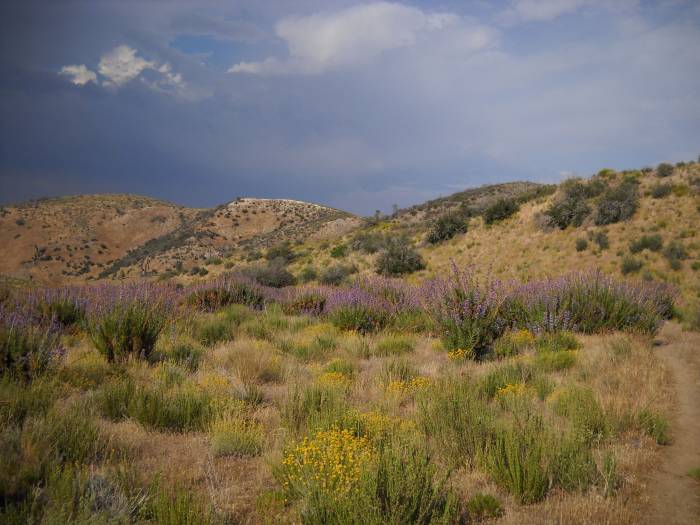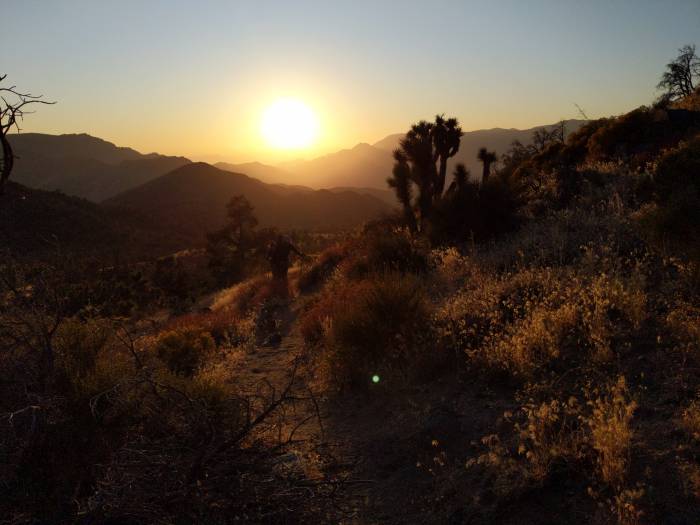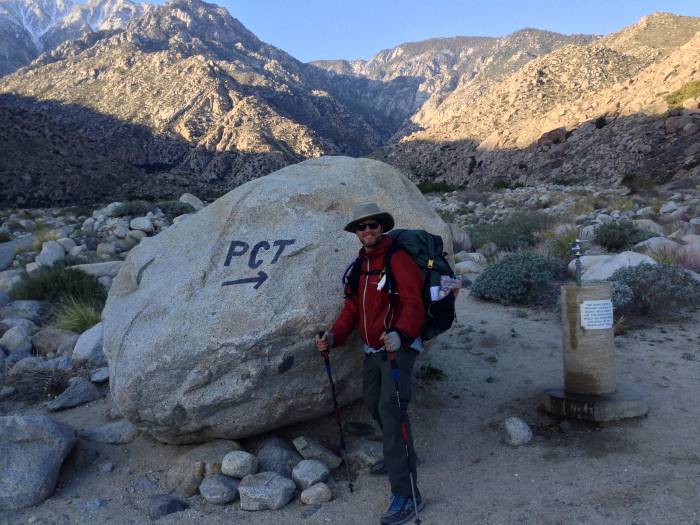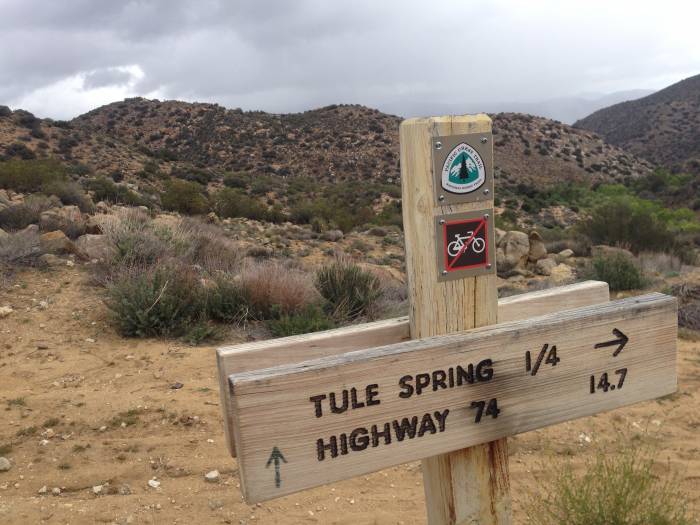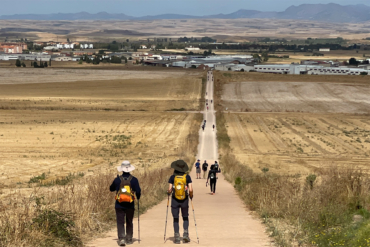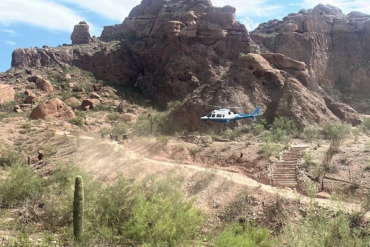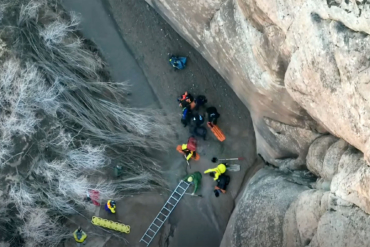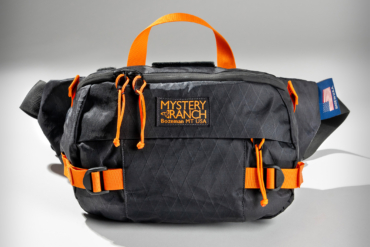Check out these thru-hiking tricks for conquering desert trails that any hiker can use, from calculating water use to avoiding the heat.
You don’t have to dedicate months to adventure in the desert like a Pacific Crest Trail hiker. But with these thru-hiking tips, your trips to drier climates can be safer and more fun.
Each spring, PCT thru-hikers start their 2,650-mile journey with 700 miles of desert. They encounter rattlesnakes, back-to-back 100-degree-Fahrenheit days, and 30-mile, waterless stretches. Ever wonder how they do it?

I’ve thru-hiked the PCT and logged more than 20,000 miles on other distance trails. I wrote a book about thru-hiking and teach workshops to aspiring thru-hikers on surviving the first month on the trail.
However long your hike is, here are my top desert tips you can incorporate.
Time your hike with the seasons.
Got a choice when you’re visiting the desert? It seems obvious, but aim for spring or fall when creeks still flow and temps are cooler. Plus, wildflowers abound in March and April, so it’s prettier too.
PCT hikers base their start dates on the climate. The trail winds through true desert, but it’s often in semi-arid mountains. High elevations can get snow — so keep that in mind when you hike in the desert.
Hike early, siesta, then hike late.
PCT thru-hikers time daily hiking hours with Earth’s heating and cooling cycles.
How it works: Thru-hikers walk at first light, packing camp by headlamp. When temps are up and bodies have to work extra hard to cool, they nap in whatever shade they can find. After sitting out the most dangerous times of day, hikers are back at it, walking until dark.
On one of my PCT section hikes, I started on June 1 (not advised). To make miles during the coolest hours, I night-hiked. It’s a common PCT strategy that requires good eyesight, a solid headlamp, and no fear of the dark.
Camel up on water.
Dehydration can reduce aerobic endurance performance, and it’s even worse in the heat. “If you’re dehydrated, you’re already shooting yourself in the foot,” warns Shawnte Salabert, author of “Hiking the Pacific Crest Trail: Southern California.” “You’re compromising your whole entire hike.”
A common thru-hiker hydration tip is “camel-ing up”— drinking as much water as possible before filling up bottles and hiking on. No matter the distance of your hike, do like a dromedary and cache water in your body. Water in your belly is water you don’t have to carry on your back.
Electrolyte yourself.
Camel-ing water may be great for hydration, but do it too much, and you can find your salt-to-water balance out of whack — a condition called hyponatremia.
Along with losing moisture when sweating, desert hikers lose salts. I’ve seen bonking hikers bounce back after taking electrolytes. I recommend adding them to all your clean water bottles for all your hikes. (But don’t add electrolytes to a hydration bladder — if there’s any sugar, it can develop mold).
Take care of your feet.
The first month of any thru-hike means blisters for almost everyone. But PCT hikers have it extra bad. Feet sweat from the heat, and desert sand sneaks into shoes. Hikers soon learn the important equation: Moisture + rubbing = hot spots.
To reduce sweaty feet, most thru-hikers wear a mesh hiking shoe (aka not waterproof). They pair these with wicking socks to draw moisture from the skin and lightweight gaiters to keep out sand.
Seasoned hikers make a routine of removing socks and shoes at every break. This process dries out the feet and shoes.
Salabert says she finds it worth carrying extra water to clean her feet. “Even if it is just a soaked bandana to wipe my feet before I get in my sleeping bag,” she tells me, it can boost morale.
Experiment with cowboy camping.
Most backpackers are all about the tent, but many thru-hikers sleep out right under the stars. By the time most PCTers start, the “wet season” in SoCal is over. Cowboy camping cuts down the time to set up for bed each night. It’s easier to pack up before dawn when there’s nothing to pack.
To be clear, always carry a shelter of some sort, like a tarp. Speaking as a local, when it rains, it pours in SoCal. You don’t want to be caught without.
Do water math.
Salabert recommends desert hikers practice “water math.” Using maps, apps, and the PCT Water Report, she measures distances between reliable water sources. Then she divides that mileage by her rate of water consumption.
“The average person,” she told me, “drinks 1 L per 5 miles.” Climbs and a heavy pack mean you’ll need more. So does temperature. “Once you’re into the 70s or 80s, you’re going to have to pump that up considerably,” she added. Acclimating to the dry climate of the desert before you start your hike can help.
Go stoveless.
PCT thru-hikers do whatever it takes to carry lighter packs. Sometimes that means forgoing hot food. Going stoveless means you don’t need to plan, carry, or ration water around meals. It means less time doing camp chores, too.
Hike with an umbrella.
While it hasn’t caught on with day hikers yet, carrying a Silver Shadow sun umbrella is the telltale sign of a PCT thru-hiker. Salabert says, “I know it saved my hide quite a few times when I was hiking.” Portable shade makes it easier for hikers to keep their core body temperature in check.

